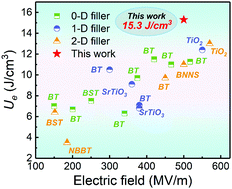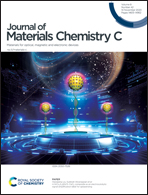Significantly enhanced energy storage performance of flexible composites using sodium bismuth titanate based lead-free fillers
Abstract
Flexible dielectric capacitors, especially polymer-based composites, have received increasing attention for use in sustainable energy and high power applications. Here, a strategy is proposed to combine antiferroelectric and relaxor features to achieve flexible films with high dielectric permittivity and energy-storage density. Based on this motivation, a lead-free dielectric ceramic Na0.5Bi0.5TiO3–Sr0.7Bi0.2TiO3 (NBT–SBT) was investigated and the corresponding thin-film composites were fabricated. A record-high energy density of 15.3 J cm−3 at 500 MV m−1, together with a high dielectric permittivity of 10–12, was achieved by the 4 wt% NBT–SBT/PVDF composite, which is 3 times that of PVDF. Furthermore, the composite films exhibit both excellent fatigue resistance and cycle stability. In addition, the COMSOL simulation proves that the composite composed of 4 wt% fillers has the best resistance to breakdown strength, which is consistent with the experimental results. Utilizing fillers with antiferroelectric and relaxor features to obtain high energy density in dielectric composites will provide new perspective and understanding for dielectric energy storage devices, which is highly desired for the next revolution of advanced electronics.



 Please wait while we load your content...
Please wait while we load your content...